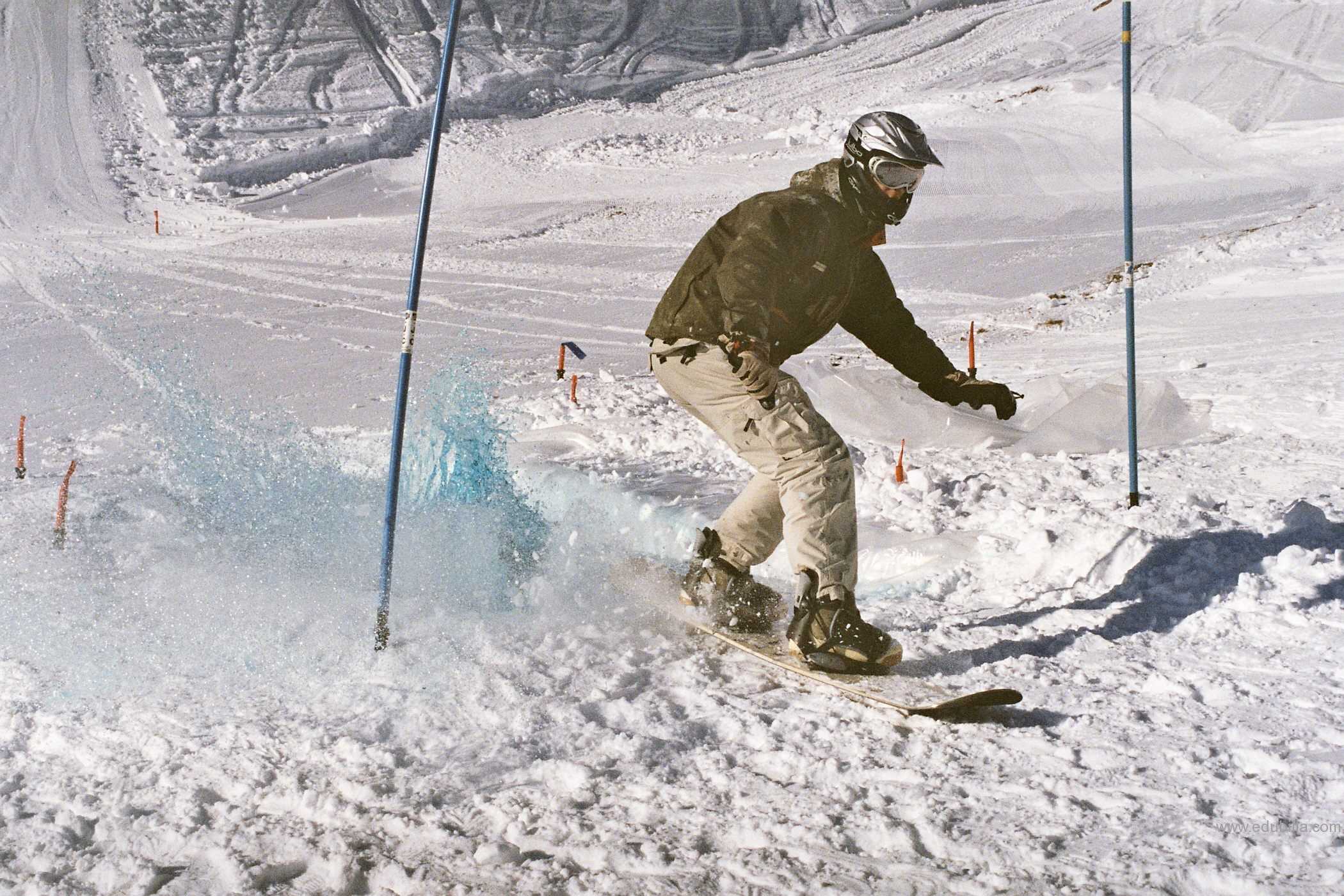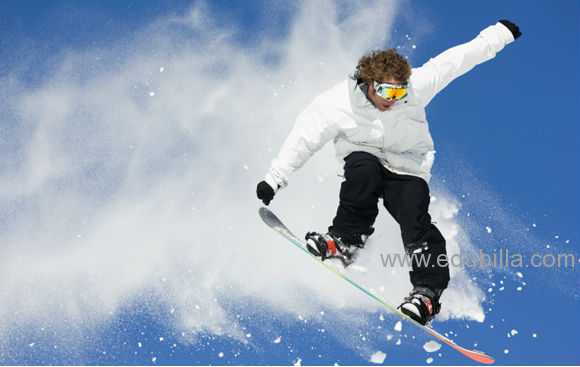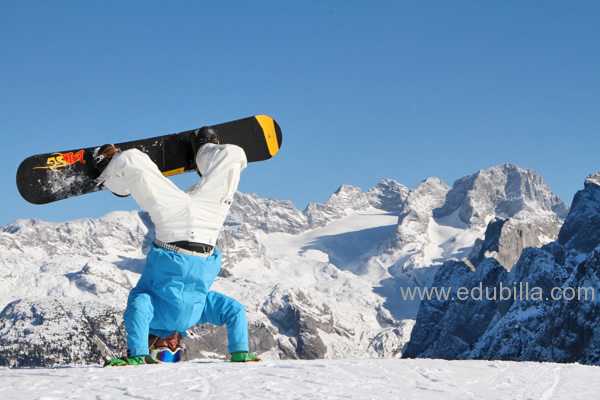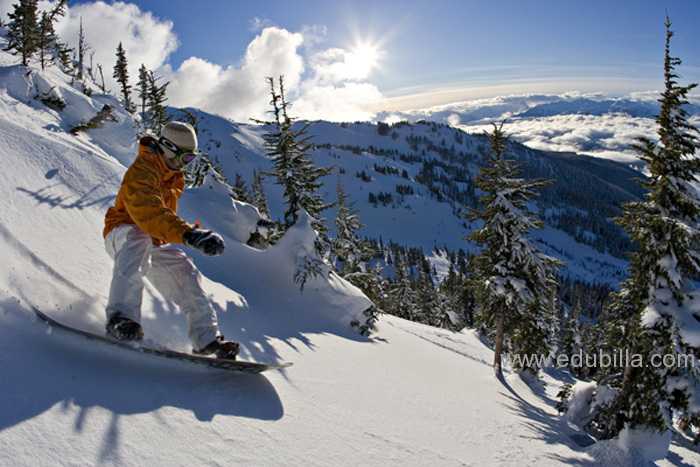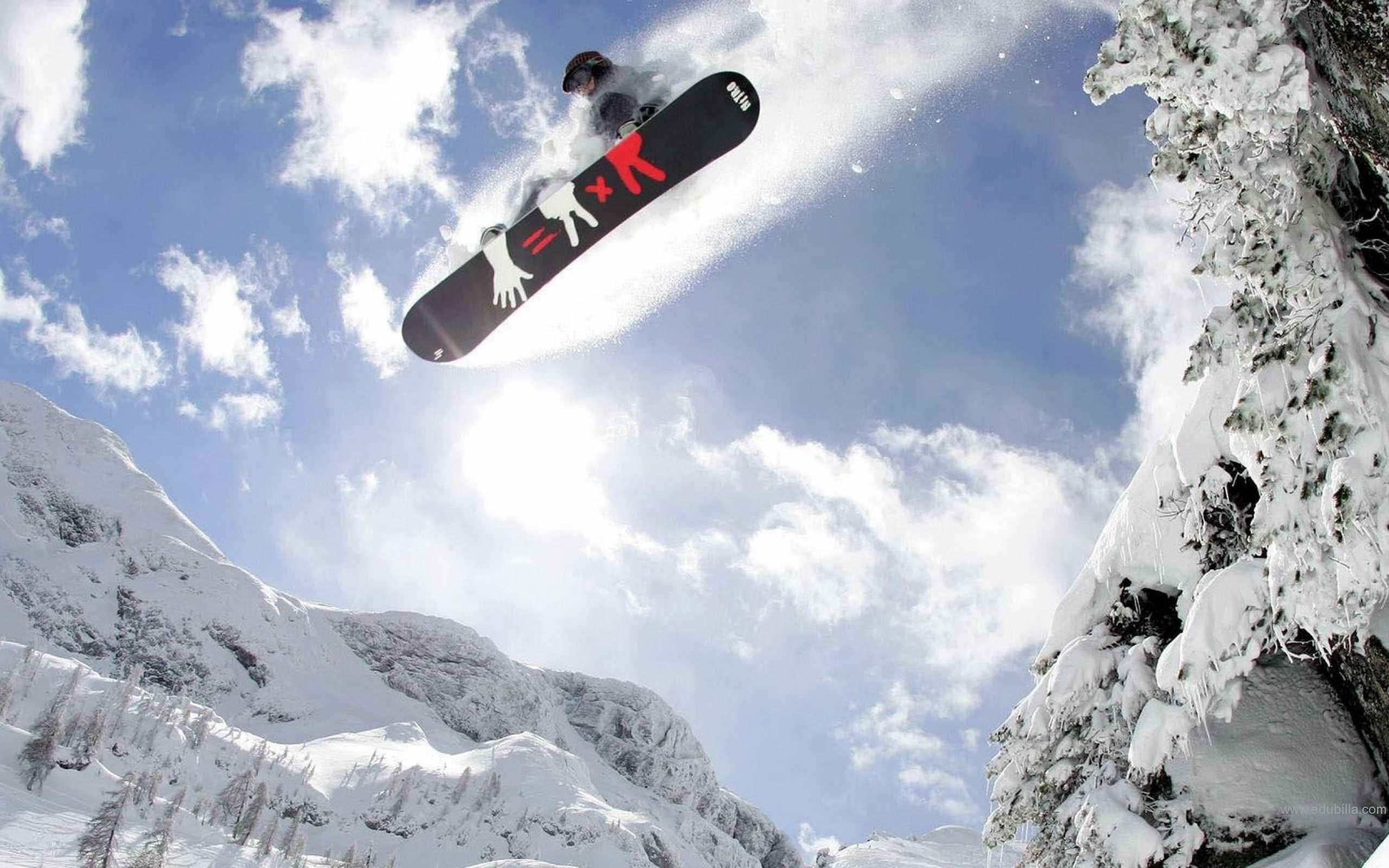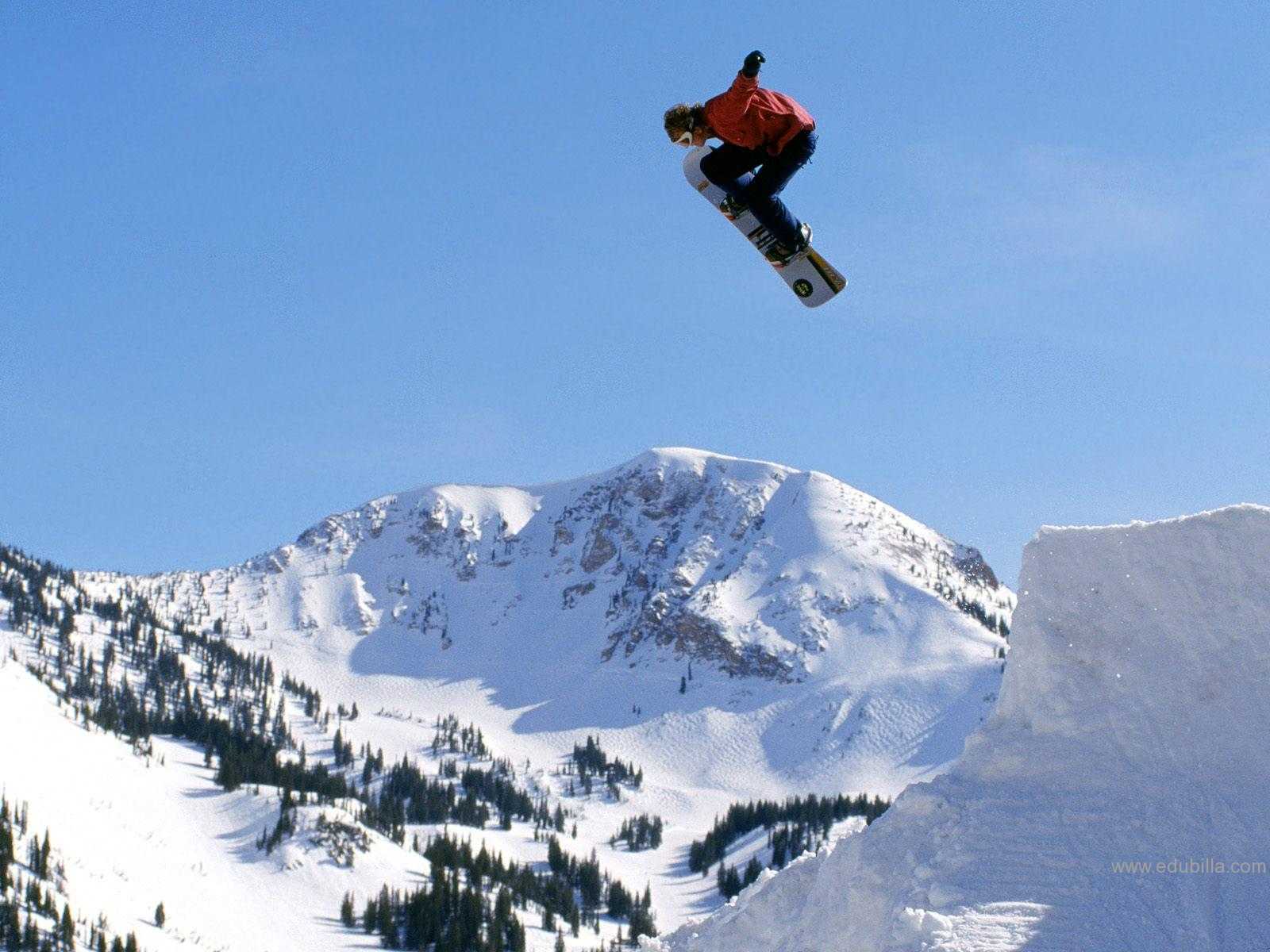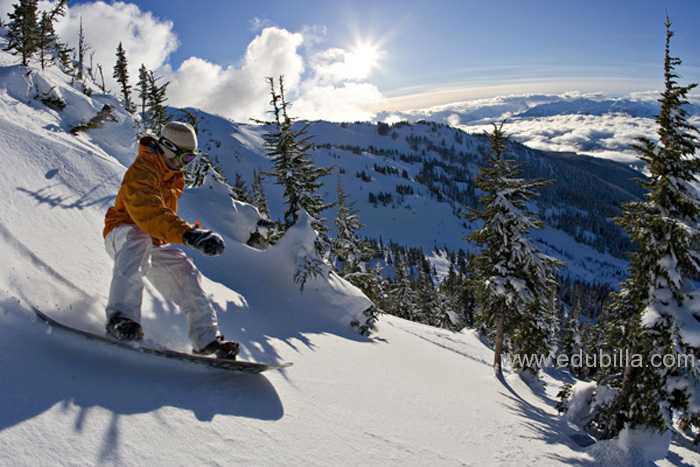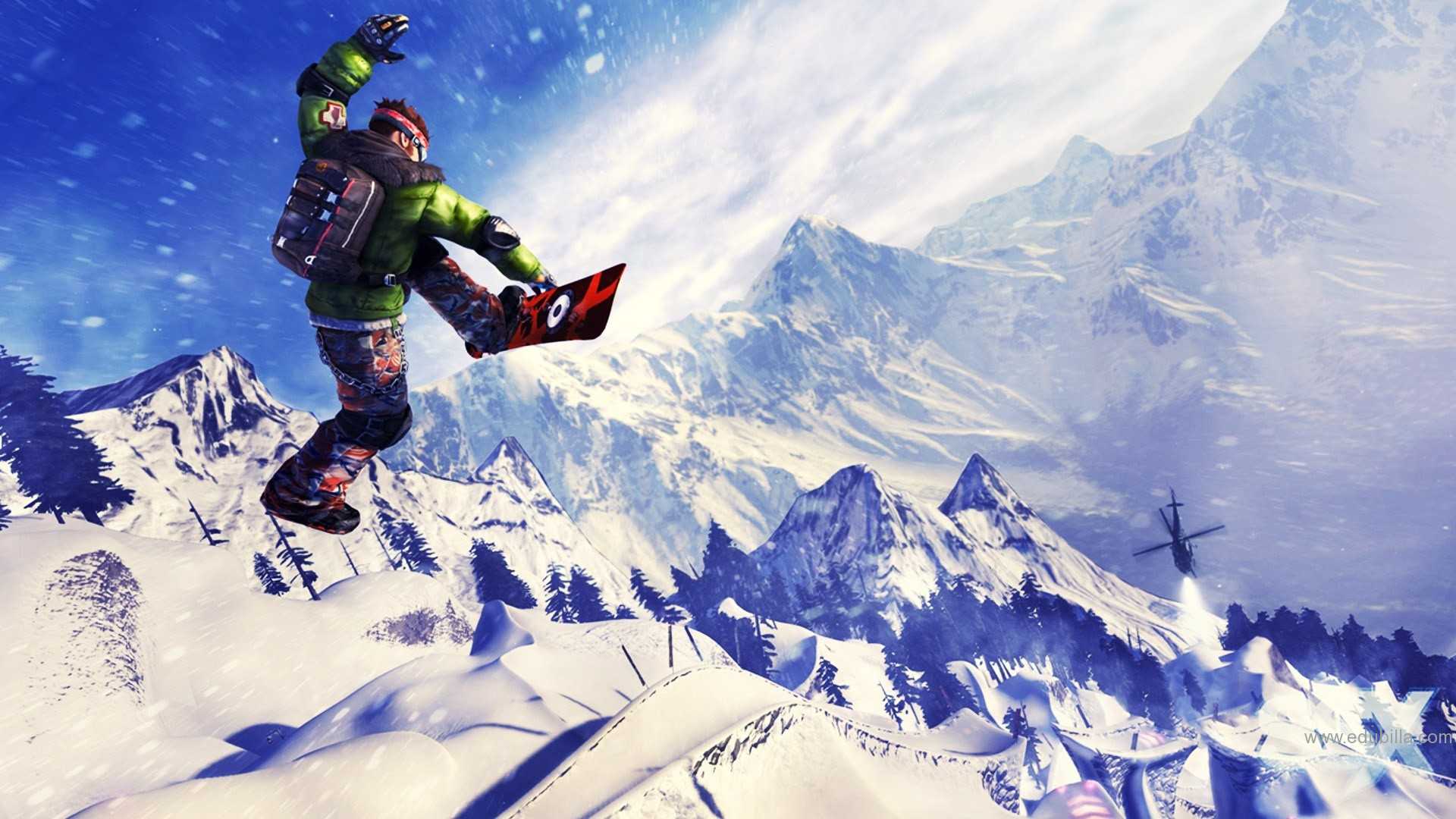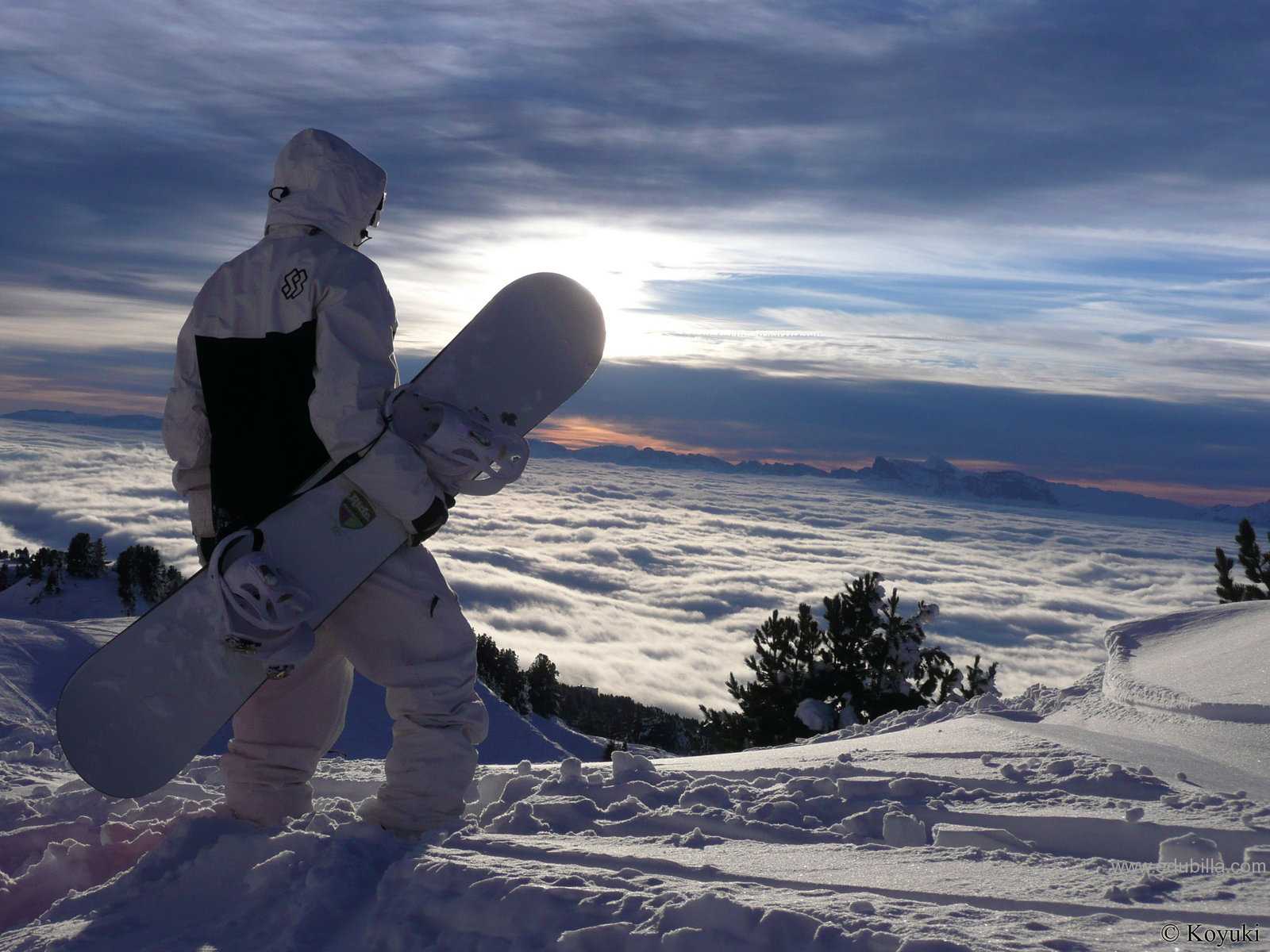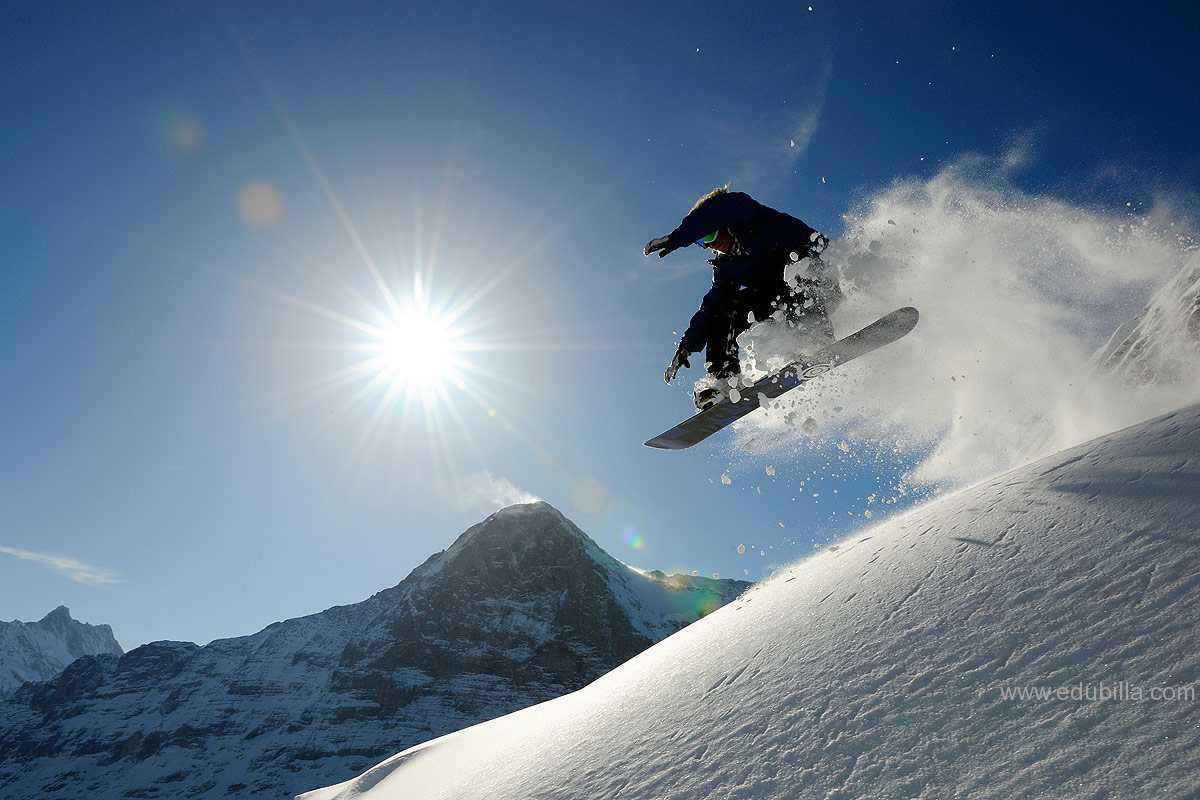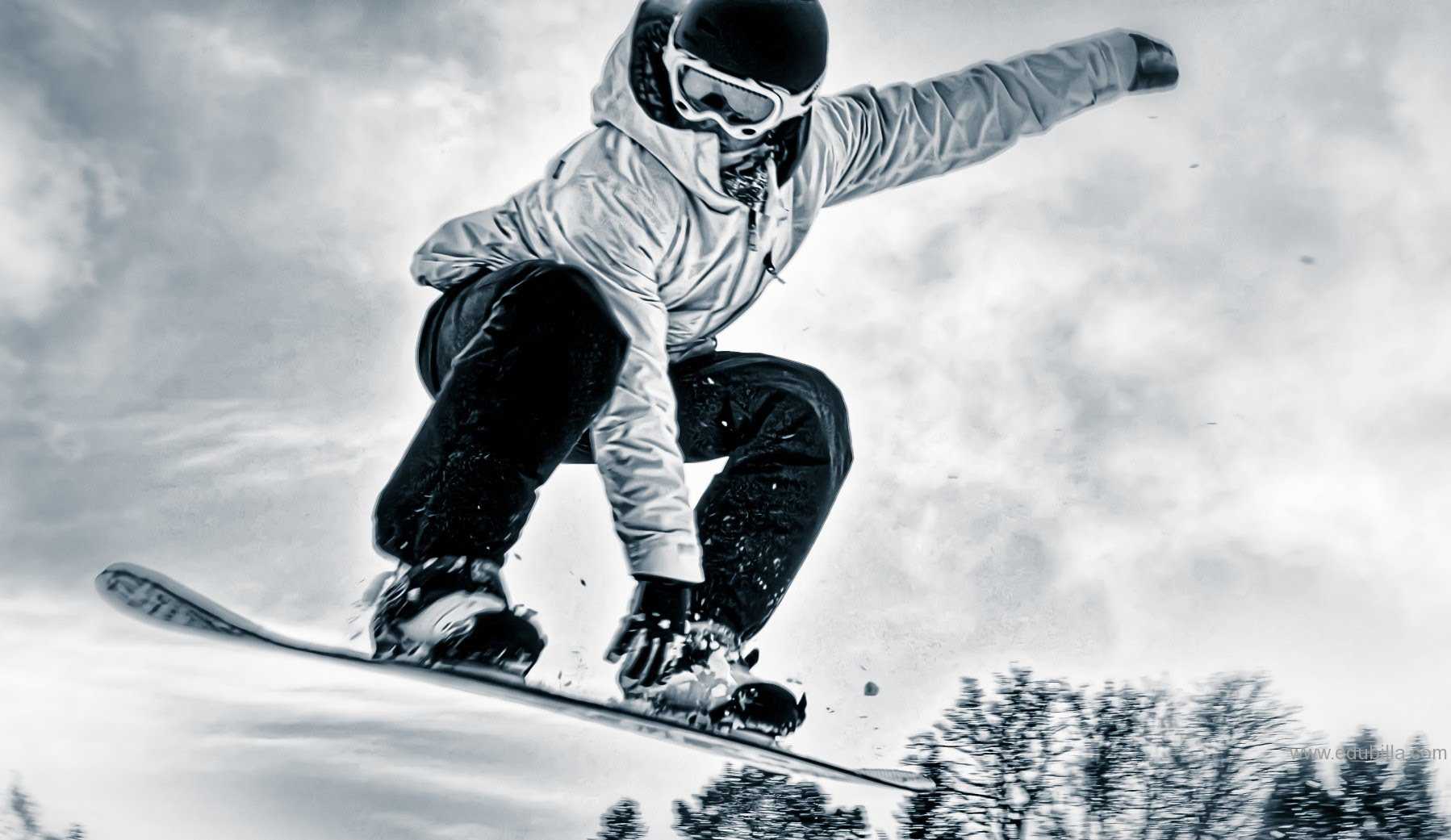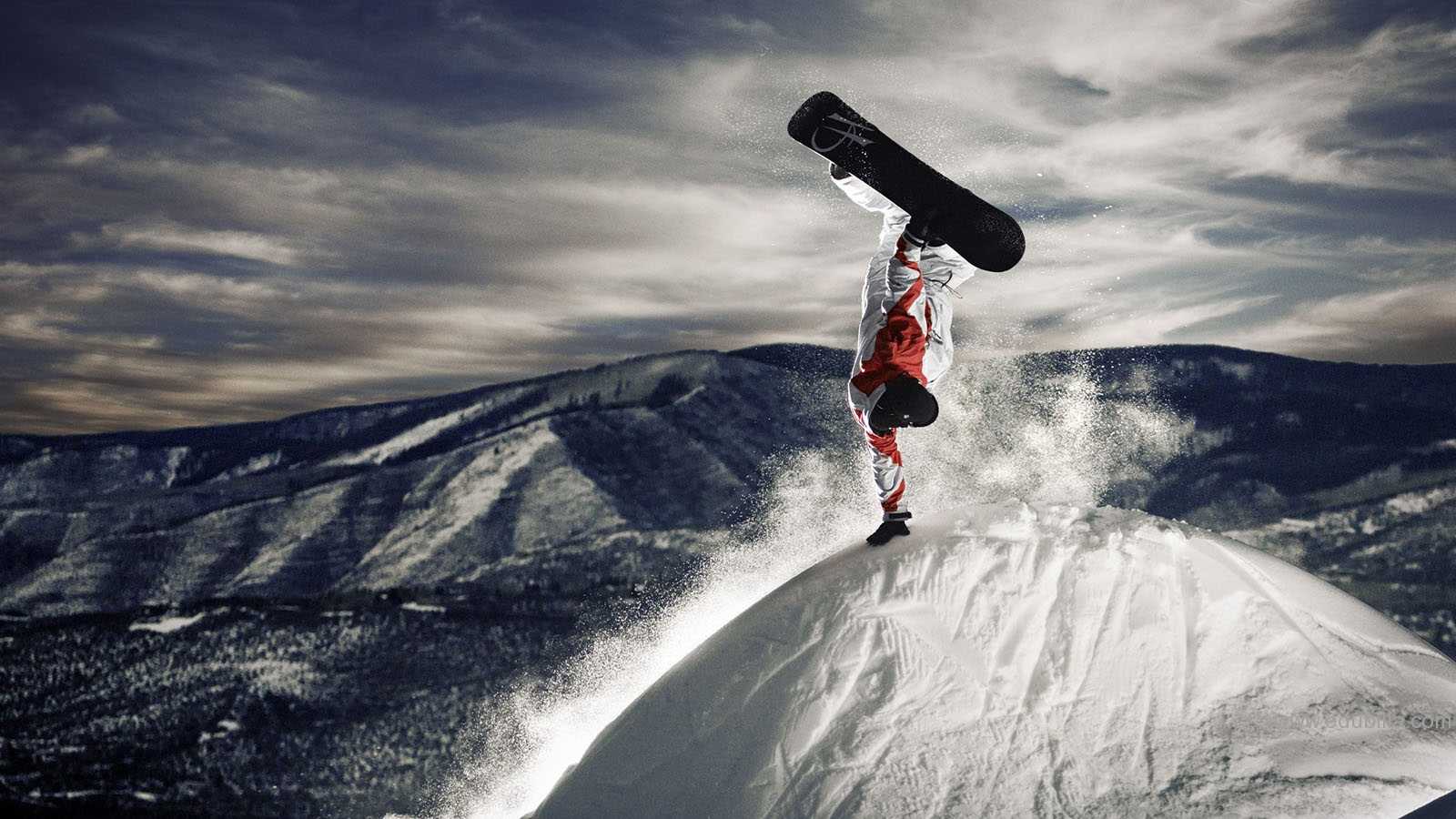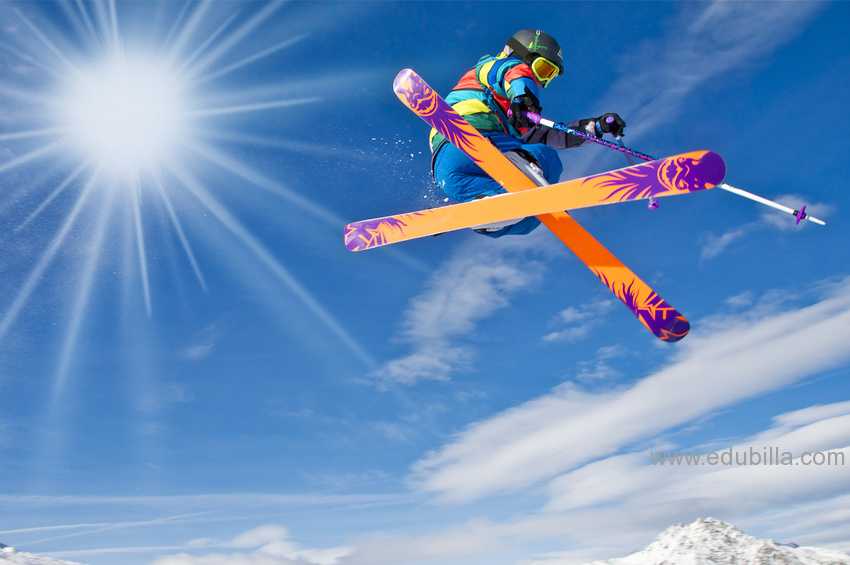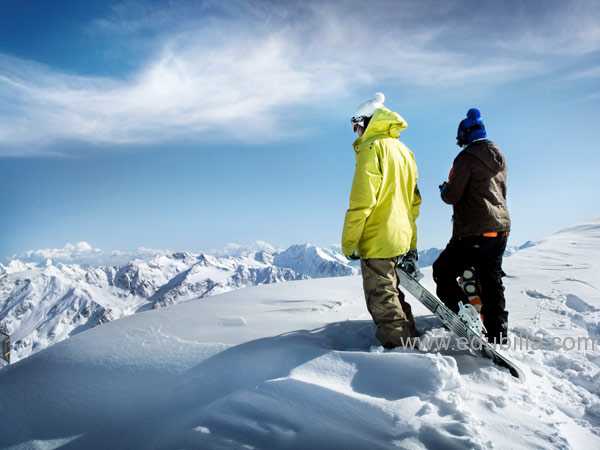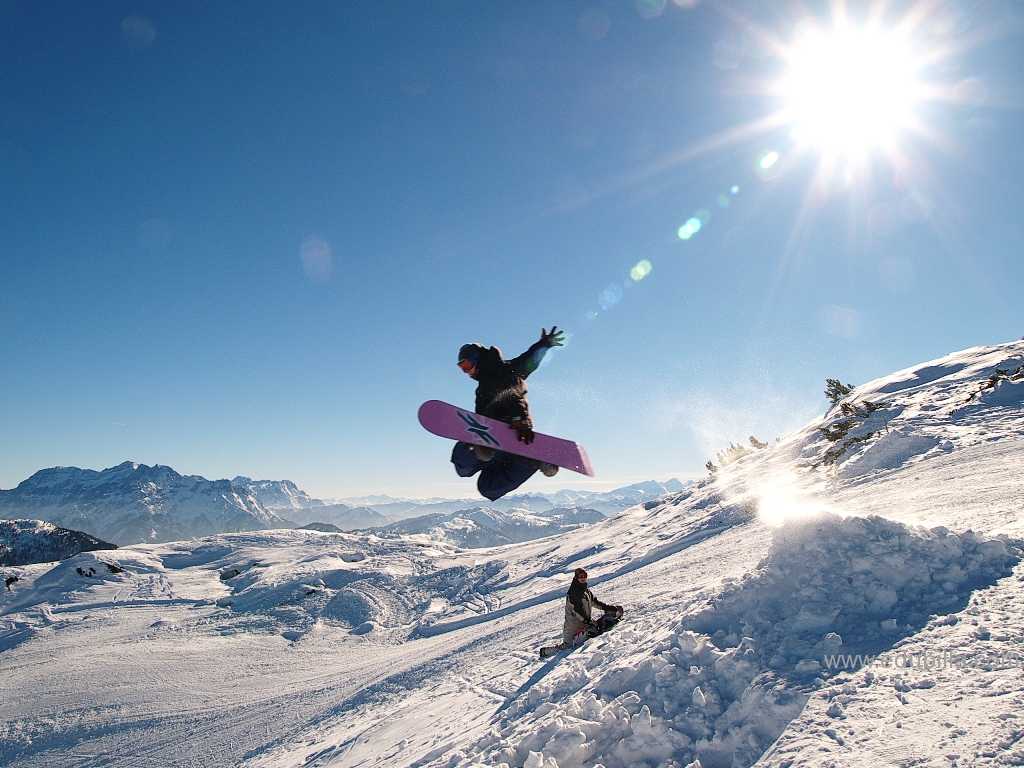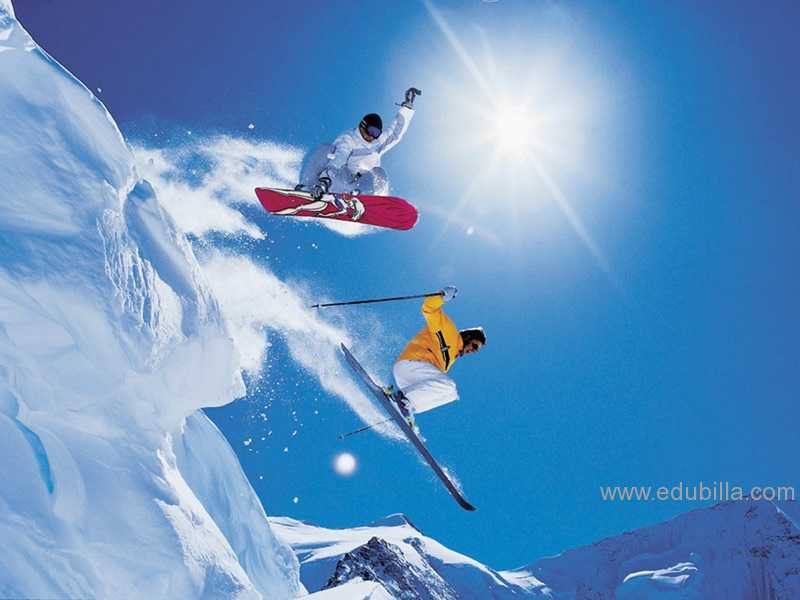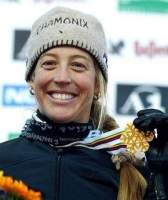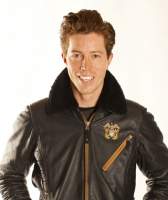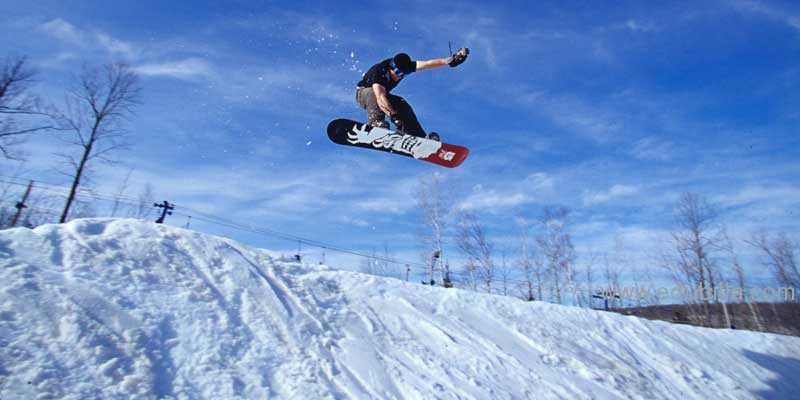
Overview Of Snowboarding
Snowboarding is a recreational activity and olympic sport that involves descending a slope that is covered with snow while standing on a snowboard attached to a rider's feet.
The development of snowboarding was inspired by skateboarding, sledding, surfing and skiing. It was developed in the United States in the 1960s and became a Winter Olympic Sport in 1998. Its popularity (as measured by equipment sales) peaked in 2007 and has been in a decline since.
Styles:
- Jibbing
- Freeriding
- Freestyle
- Alpine Snowboarding
- Slopestyle
- Big air
- Half-pipe
- Boardercross
- Snowboard Racing
Media:
Films:
Snowboarding films have become a main part of progression in the sport. Each season, many films are released, usually in Autumn. These are made by many snowboard specific video production companies as well as manufacturing companies that use these films as a form of advertisement. Snowboarding videos usually contain video footage of professional riders sponsored by companies. An example of commercial use of snowboarding films would be The White Album, a film by snowboarding legend and filmmaker Dave Seoane about Shaun White, that includes cameos by Tony Hawk and was sponsored by PlayStation, Mountain Dew and Burton Snowboards. Snowboarding films are also used as documentation of snowboarding and showcasing of current trends and styles of the sport.
Magazines:
Snowboard magazines are integral in promoting the sport, although less so with the advent of the internet age. Photo incentives are written into many professional riders' sponsorship contracts giving professionals not only a publicity but a financial incentive to have a photo published in a magazine. Snowboard magazine staff travel with professional riders throughout the winter season and cover travel, contests, lifestyle, rider and company profiles, and product reviews. Snowboard magazines have recently made a push to expand their brands to the online market, and there has also been a growth in online-only publications. Popular magazines include Kronicle (USA), Transworld Snowboarding (USA), Snowboarder Magazine (USA), Snowboard Magazine (USA), snowboarderMBM (Germany),Yobeat, (USA) Whitelines (UK), Pleasure (Germany), Method (Europe), Onboard (Europe), Whiteroom Magazine (BG), Snowboard Canada (Canada),NZ Snowboarder, (New Zealand) and Snowboard Colorado, (USA).
Video games:
Snowboarding video games provide interactive entertainment on and off season. Most games for this genre have been made for consoles, such as the Xbox and PlayStation. A plethora of online casual snowboarding games also exist along with games for mobile phone. More recently, snowboard simulators have been implemented as a way to practice during the off season or a way to learn altogether.
Game Rules
- Basic snowboarding rules are written to safeguard snowboarders and other riders. Since there is a high possibility of injuries that can take place, the rules are mostly common sense and aim to keep the rider and others safe on the mountains.
- The first and the most important rule that everyone needs to follow is to know one's abilities and keep away from risky snowboarding stunts. Watching professional and experienced snowboarders, it is easy to believe that one can also pull off the stunts that they are doing. However, these are not as easy as they may seem. It takes time and dedication to master huge cliff jumps and controlling the board at high speeds.
- A snowboarder has to remember to stay out of the way of other snowboarders at all times. It is important that a snowboarder does not stop in the blind spots such as below a catwalk or at the bottom of a jump. It is hard for other riders to turn their board when falling on the force of gravity. When riding behind someone, the person in the front has the right of the way and no matter how fast or slow this person is going, the snowboarder at the back has to slowdown. It is also necessary that a person stays within the boundaries of the snowboarding range and avoid going outside the marked boundaries. There is a high risk of avalanche in unexplored areas and unless one is experienced in riding in unexplored backcountry terrain, and is riding with avalanche gear and beacon, it is not recommended that one crosses boundaries.
- When sloping down from a higher slope an area where other skiers or boarders are present, it is important that one alarm the others below to make way and stop others from riding, since the speed of the person riding from the top is higher than the one below. This avoids collisions and avoids injuries.
- The International Ski Federation formulated the rules and regulations that need to be followed by contestants and organizers at international snowboarding championships. The intent of the rules and regulations are to create a friendly, competitive, fair and fun atmosphere for the competitors. The number of judges and other personnel running a competition are defined in the rules and regulations. The races are timed and competitors are ranked with snowboarders from around the world. All false starts are considered as disqualifications. The rules also specify that participants wear back protection to safeguard their spines in crashes. Detailed style specific rules and regulations vary from style to style and even vary in different competitions.
Equipments Need For Snowboarding
Halfpipe board
A wide and flexible board is essential for balance and tricks. It allows the boarder to ride forward and backward (twin tip snowboard).
Hard boots
The boots designed for parallel giant slalom and the other Alpine events. The boots are stiff and provide good support.
Heel edge
The edge of the snowboard closest to the heels.
Helmet
A hard plastic helmet may be used in Alpine events. It is required for all competitors in snowboard-cross and halfpipe competitions.
Soft boots
Boots designed for use in freestyle and freeride snowboarding. They are made soft and pliable to allow a broad range of motions.
Alpine board
Alpine boards are stiff and narrow, which is ideal for turns and high speed.
Snowboard cross board
Designed to allow high speed, combined with a maximum of tolerance and flexibility to avoid mistakes in the jumps and obstacles.
Halfpipe boots
Halfpipe boots allow movement at the ankles to execute different manoeuvres. The rubber/urethane parts of the boots absorb shock.
History Of Snowboarding
Snowboarding History Timeline:
- 1980–Burton and Winterstick both utilize a P-Tex base on their prototypeboards, introducing ski technology to the industry.
- 1980–Chris Sanders buys a Snurfer and when it disintegrated he built his own board, which would later lead him to founding Avalanche Snowboards.
- 1981–After working with early developments at Sims, Chuck Barfoot leaves to form his own, self-named snowboard company.
- 1981–Modern competitive snowboarding begins with a small contest held in April at Ski Cooper in Leadville, Colorado.
- 1982–Paul Graves organizes the National Snowsurfing Championships held at Suicide Six Ski Area in Woodstock, Vermont, featuring a slalom and downhill. Racers in the downhill were allegedly clocked going speeds in excess of 60 m.p.h. This is the first time riders from all over the country compete against each other including rivals Tom Sims and Jake Burton Carpenter. Tom Sims was victorious in the downhill but fractured his thumb crashing into the haybales at the finish line. Burton team rider Doug Bouton wins first overall. The contest also features the first amateur division. It’s also the last time Snurfers and snowboards race together. The contest draws media coverage from the likes of Sports Illustrated, NBC Today, and Good Morning America.
- 1982–Avalanche Snowboards founded in South Lake Tahoe by Chris Sanders and Earl Zeller. They made three boards the first year and named them Huey, Dewey, Louie. The boards had Formica bases and top sheets, and a mohogany doorskin core.
- 1983–Jake Burton Carpenter puts on the National Snowboarding Championships in the spring at Snow Valley, Vermont. Tom Sims then goes home and holds the inaugural World Snowboarding Championships at Soda Springs Ski Bowl in the Lake Tahoe area. This is the first contest to have a halfpipe event. Jake Burton, Andy Coghlan, and the Burton team members threatened to boycott the event because they felt halfpipe had nothing to do with snowboarding and should not be considered in the overall.
- 1983–Jeff Grell designs a highback binding, enabling boards to be ridden effectively on hardpack. The bindings were first used on Flite snowboards, but later developed for Sims. Other’s claim a highback was built earlier by Louis Fornier so Jeff’s claim to the highback is up for discussion.
- 1985–In January, Mt. Baker hosts the first Mt. Baker Legendary Banked Slalom which becomes a competitive mainstay. Tom Sims wins.
- 1985–Thrasher covers the World Championships at Soda Springs, and give some of the first magazine exposure for a snowboarding contest.
- 1985–Absolutely Radical, the first magazine exclusively about snowboarding, appears in March. Six months later the name is changed to International Snowboard Magazine.
- 1985–Metal edges are introduced on Sims 1500 FE and Burton Performer models, their winter production models. This ends the era of surfing-influenced fin design once and for all as snowboards become more compatible with ski technology.
- 1985–Sims introduces the first signature model snowboard in their winterline, bearing Terry Kidwell’s name. The Kidwell is also the first freestyle board with a rounded tail.
- 1985–Mike Olson Gnu boards are the first to be marketed as a carving board, where turns are made on edge rather than slided.
- 1986–Europeans begin to organize their own regional events, such as the Swiss Championships in St. Moritz.
- 1986–The Swiss winner of some of those European races, Jos Fernandes, comes to America with an asymmetrical board, the forerunner to asym production models popular in the early 90s. The board is made by his sponsor, Hooger Booger.
- 1986–The World Snowboarding Championships, or The World’s, as it has became known, relocates from Soda Springs to Breckenridge, Colorado. The March event draws big money from Swatch and gets some of the most national recognition to date. Probably the most ground breaking is done when Fran Richards, Paul Alden and Dave Alden convince the Breckenridge management tthat the halfpipe is not a high-speed event.
- 1986–During this winter, Stratton Mountain in Vermont becomes the first resort to offer organized snowboarding instruction.
- 1986–Sims Snowboards is licensed by Vision in December.
- 1986-’87 Season–With a lace-up, ski-boot inner bladder, Burton produces what will become the standard design for soft-boot snowboarding.
- 1987–Chuck Barfoot and his company introduce the first twin-tip freestyle shape with an identical nose and tail. The board is designed by Canadians Neil Daffern, Ken and Dave Achenbach.
- 1987–Europeans host their own World Championships in January at Livigno, Italy and St. Moritz, Switzerland. This event is not to be confused with the other World Championships, held at Breckenridge, Colorado later the same year.
- 1987–The day after the 2nd Breckenridge World’s in March, Paul Alden and a collection of riders and manufacturers form the North American Snowboard Association (N.A.S.A.) The acronym is later changed to N.A.S.B.A. because N.A.S.A is already taken. The association’s main goal is to work with the Snowboard European Association (S.E.A.) to create a unified World Cup tour.
- 1987–A host of early snowboarders, including Dave Alden, pen the first PSIA manual for snowboard instructors.
- 1987–Transworld SNOWboarding Magazine publishes first issue in the fall.
- 1987–In September, Wrigley’s chewing gum utilizes snowboarding in a national commercial. Craig Kelly, Bert LaMar, Tom Burt, and Jim Zellers appear in an aerial romp filmed by Greg Stump.
- 1987-’88–The first World Cup is held through out the season with two events in Europe and two in the United States. The circuit also introduces major corporate sponsorship (O’Neill, Suzuki, and Swatch) into the competitive arena.
- 1988–Veteran surf company Ocean Pacific warms up to snowboarding by developing their own line of winter clothing. Other surf companies soon follow andcapitalize on the crossover between the two sports.
- 1988–Further action sport involvement comes when surf and skate manufacturer G&S enters the market. By 1990, G&S exits the snowboard market.
- 1988–While the two major snowboard manufacturers, Burton and Sims, battle over Craig Kelly in court, he is ordered by a federal judge not to ride any products bearing any logo other than Sims. Kelly then starts riding blackboards with no logo. The restraining order is later reversed in court and Kelly signs a long-term deal with Burton.
- 1988– Former amateur surf promoter Chuck Allen incorporates the United StatesAmateur Snowboarding Association (USASA) in July with a $500 donation fromTransworld SNOWboarding Magazine. USASA is the first governing body exclusively for competitive amateur snowboarding.
- 1989–Earl A. Miller, an engineer and inventor from Utah, produces a releasable snowboard binding, but the technology has yet to hit the mainstream.
- 1989–Just in time for the coming winter, most of the major ski resorts that had previously resisted snowboarding succumb, such as Squaw Valley, California; Mammoth Mountain, California; Vail, Colorado; Sun Valley, Idaho; and Snowbird,Utah.
- 1989–OP continues to delve into the snowboarding market by expanding their popular OP Pro of Surfing to include the OP Pro of Snowboarding. The contestis held at June Mountain, California.
- 1989–October. Rob Morrow leaves his Sims sponsorship and with business help from his uncle starts Morrow Snowboards in Salem, Oregon.
- 1989–The first National Collegiate Championships are held in December at Stratton Mountain, Vermont. Soon, college teams and clubs sprout like weedsthroughout the country.
- 1990–Jake Carpenter buys the patent for the “skiboard” from its designer Bob Webber. Burton’s lawyers send out a letter asking for three percent of everyone’s total sales, Jake makes it look like he is being squeezed by some outside force into paying the royalties as well. The industry eventually finds out that Burton is behind both letters and dares Jake to enforce the patent. Jake doesn’t and claims he bought the patent to keep Brunswick from buying and ruining the industry. Nothing happens.
- 1990–The USASA holds their premiere national championships in February, at Snow Valley, California. The worst snow storm of the decade hits just before the event and closes all roads to Big Bear. Amateur snowboarders from all over the country are left stranded. A rescue caravan of locals led by USASA president Chuck Allen sneaks the competitors past the police barricadesand gets them to the contest on time.
- 1990–In June, Breckenridge Ski Corp. announces plans to house the Snowboarding Hall Of Fame, with artifacts from the sport’s not-so-distant past.
- 1990–Santa Cruz Skateboards owner Rich Novak starts producing a line of snowboards. Other skate companies like H-Street decide to test the waters with their own board and clothing designs.
- 1990–Vail Ski Resort tries a new approach by developing an in-bounds obstacle area called a “snowboard park.” The area is intended to cater to a growing snowboard market and other resorts quickly follow suit.
- 1990– The International Snowboard Federation forms after the collapse of the National Association of Professional Snowboarders. Headed by Ted Martin, Kazuo Ogura, and Christian Savioz. The idea is to be a sanctioning body forinternational competition.
- 1991–By now, the pro surfer/pro skater crossover to snowboarding is prevalent.Skaters Steve Caballero and Lance Mountain have been riding since the early 80s at least, Tony Hawk, Kevin Staab, and Joe Johnson have been riding for years. Surf standouts like Gary Elkerton, Mike Parsons, and Noah Budroe bite the snowboarding bait, and most other pro surfers ride regularly, have tried it, or at least have developed an opinion or two about it.
- 1991– The 1991 Victoria World Cup Japan is held at Rusutsu Resort on Japan’s north island. With over one-million dollars spent on the contest it was the richest contest so far.
- 1991–After a lengthy court dispute over the Sims name, Tom Sims wins back the licensing rights from Vision in February. Vision begins production under its own name and Tom resumes making a new Sims line.
- 1991–The Op Wintersurf contest held in February pits pro surfers and snowboarders against each other in a surf contest at Huntington Beach and a snowboard obstacle course/race at Bear Mountain. Top international pro surfer Gary Elkerton scores the win, proving it’s a lot harder to learn how to surf than snowboard.
- 1992– The United States Ski Association decides to finally become involved with snowboarding. With back room political help from Paul Alden the USSA tries to merge with the USASA. Negotiations fail between the two groups.
- 1992– Ken Achenbach and some friends produce a baseless soft binding called “Simply Filth.” Most in the industry shrug it off as another of Ken Achenbach’swild ideas.
- 1992–February 17. During a photo shoot at Squaw Valley, California, snowboarder Steve Graham accidentally collides with photographer Bud Fawcett resulting in nerve damage to Fawcett’s left arm. This results in a court battle which no one will talk about.
- 1993– January. The International Snowboard Federation holds its first official Snowboard World Championships in Ischgl, Austria. American’s Kevin Delaney and Michele Taggart win the combined titles.
- 1993– Snowboarding’s third wave of snowboard manufacturers spring up andin the fall of 1993 there are over 50 different companies marketing snowboards to the consuming public.
- 1993– One of the companies is Type A run by Plan B owner Mike Ternasky. It is seen as theirst of the third wave/hardcore skateboard companies to enter the snowboard market.
- 1993– Closely on Type A’s heels comes Blunt, a snowboard magazine created in Vista, California by Ken Block of Droors clothing and Circus Distribution. The magazine is slick, nasty, and quickly gains the attention of the snowboarding industry for it’s use of video grabs and full color graphics. Some disparagingly refer to it as “Big Brother’s little bro.”
- 1993– The Federation Ski International (FIS), the international organizational body for skiing and Olympic skiing votes to recognize snowboarding at their June meeting. Plans for several events in 1994 and a full-fledged World Cup Tour in
- 1995. The snowboard industry is wary of this bureaucratic giant. Many feelthis kind of organization will be bad for the sport.
- 1993– Snowboarder TV goes on the air of ESPN with host G.T. (Greg Tomlinson).The show features great riding, music and very little talking. It is well received.
- 1993– Following on the success of 411 a skateboard video magazine produced by Paul Schmitt, TransWorld Publications creates TransWorld Snowboarding Video Magazine by Mike McIntire (Mack Dawg).
- 1994–At the Lillihammer, Norway Olympics it is hoped that snowboarding wouldbe performed as a “cultural exhibition,” by the host country Norway. The FIS gets wind of the performance and forces it’s cancellation. Many believeit will not be until 1998 that the Olympics give medals for snowboarding.
- 1994– January. At a national Burton Sales meeting at Sugarbush, Vermont Jake Burton Carpenter collides with a skier and breaks his tibia and fibulaand is forced to walk about in a cast and brace for several months.
- 1994– The first Amateur World Championships are held in Slovenia.
- 1994– At the SIA Trade Show in Las Vegas, Nevada every one of the big snowboard companies introduces a baseless binding and touts it as the newest thingto hit snowboarding. At the same show Burton and Snow Pro display step in hardboot bindings to slightly less fanfare.
- 1994– Spring. Two organizations hold amateur national championships. The USSA holds theirs at June Mountain, California. And the USASA holds theirs at Sierra at Tahoe, California. Both claim to have the “official” national team.
- 1994–Matt Goodwill wins the King of the Hill competition in Valdez, Alaska.It is his second extreme world championship title. Julie Zell was crowned Queen of the Hill.
- 1994– May, 6. Ride Snowboards becomes the first snowboard company to go public on the NASDAQ stock exchange. They sell out the original 500,000 units in the first two weeks and another 75,000 units are released. In the sale Ride offers one unit (two shares and one warrant) for US$10. By the middle of June 1995 the share price reached $28, or six times it’s original worth.
- 1994–Spring. Volant Skis enters the snowboard market by purchasing the financially floundering company Aggression from owner Ron Romaine.
- 1994–June. At their national congress in Rio De Janeiro, the FIS membership votes to include snowboarding as a discipline in their jurisdiction. The ISF is not happy.
- 1994–July. ISF President Ted Martin writes a letter asking the IOC to recognizethe ISF as the governing body of international snowboarding. In a three sentence reply, the ISF is told to talk to the FIS about getting ISF athletes in the Olympics because “FIS governs that discipline.”
- 1994– August 1, Kemper Snowboards is purchased by California Pro in-line skates for US$1 million. The new owners move the headquarters to Greenville, South Carolina.
- 1994–August. Burton Snowboards releases the first CD-ROM interactive catalog. Taking snowboarding into the computer age.
- 1994–September. Avalanche Snowboards sells 80 percent of it’s 15 year old company to businessman Robert Edwards for an undisclosed amount. Edwards worked previously with Anthony Industries, the parent corporation of K2 Skis.
- 1994–September. Molson, the Canadian beer, uses stock snowboarding footage shot by FLF in it’s beer ad which premiers during Monday Night Football. Riders Damian Sanders, Dave Seoane, and other get small fee.
- 1995–January. The Sacramento, California-based Heckler Magazine becomes first snowboard magazine to publish on the Internet’s World Wide Web
- 1995–March. Five different manufacturers including Burton and Airwalk show step-in soft bindings. With product from Switch, Device, and T-Bone, many in the industry rush to call step-in softbindings snowboarding’s next big thing.
- 1995–Rob Morrow steps down as president of Morrow Snowboards fueling rumors of Morrow’s going public or being sold to a larger corporation. Dennis Shelton, previously of Scott and Schwinn, takes over as president.
- 1995–December. Morrow Snowboards becomes second snowboard company whenSmith-Barney takes them public. Shares open at a price of US$11.
- 1996– April 26. Ride Inc., announces that its Preston Binding Company subsidiary, together with Mark A. Raines and Gregory A. Deeney, has sued Switch Manufacturing Company for patent infringement claiming that Switches Autolock binding is too similar to the Raines binding because it attaches side to side.
- 1996–October 1. Tom Sims ends relationship with DNR/Sportsystem and files a suit in the Santa Barbara County Court for a restraining order to stop DNR from using the Sims brand name.
- This story originally appeared in TransWorld Snowboarding Magazine. Special thanks to Billy Miller and John Stouffer for compiling most of this timeline. snowboarding footage shot by FLF in it’s beer ad which premiers during Monday Night Football. Riders Damian Sanders, Dave Seoane, and other get small fee.
- 1995–January. The Sacramento, California-based Heckler Magazine becomes first snowboard magazine to publish on the Internet’s World Wide Web
- 1995–March. Five different manufacturers including Burton and Airwalk show step-in soft bindings. With product from Switch, Device, and T-Bone, many in the industry rush to call step-in softbindings snowboarding’s next big thing.
- 1995–Rob Morrow steps down as president of Morrow Snowboards fueling rumors of Morrow’s going public or being sold to a larger corporation. Dennis Shelton, previously of Scott and Schwinn, takes over as president.
- 1995–December. Morrow Snowboards becomes second snowboard company whenSmith-Barney takes them public. Shares open at a price of US$11.
- 1996– April 26. Ride Inc., announces that its Preston Binding Company subsidiary, together with Mark A. Raines and Gregory A. Deeney, has sued Switch Manufacturing Company for patent infringement claiming that Switches Autolock binding is too similar to the Raines binding because it attaches side to side.
- 1996–October 1. Tom Sims ends relationship with DNR/Sportsystem and files a suit in the Santa Barbara County Court for a restraining order to stop DNR from using the Sims brand name.
- 1965–Sherman Poppen invents The Snurfer for his daughter Wendy by boltingtwo skis together.
- 1970–Inspired by sliding on cafeteria trays in upstate New York, East Coastsurfer Dimitrije Milovich starts developing snowboards based on surfboarddesign with a rudimentary idea of how skis work. The boards had metal edges.
- 1971–According to Milovich, he is granted a patent for his snowboard designso he could sell the idea to ski companies. The patent didn’t expire until1988 and Milovich declines from enforcing the patent with other companies.
- 1969-1972–Bob Webber spends several years trying to obtain a patent forhis early “skiboard” design. This takes him until 1972 to get, and he latersells the patent to Jake Burton Carpenter on August 17, 1990.
- 1975– Dimitrije Milovich sets up Winterstick production in Utah. The metaledges from his early boards are removed because Milovich was riding powderover his head and didn’t need them. Milovich also develops a swallow-tailboard based on the same design in surfboards, and, one year later a double-edgeddesign which he got a patent on.
- 1975–Milovich and Winterstick are written up in the March issue of Newsweekand have a two-page photo spread in Powder, giving snowboarding some earlynational exposure.
- 1977–Mike Olson builds his first snowboard in jr. high wood shop. He continuedto modify boards in high school and beyond, until 1984, when he quits collegeto start Gnu.
- 1977– Jake Burton Carpenter moves to Stratton Mountain, Vermont, workingnights as a bartender and designing the prototypes for what will later beBurton Snowboards during the day. Like Sims, he also claims to have beenmodifying Snurfers since high school.
- 1977–Milovich obtains a written confirmation from Petit-Morey and KendallInsurance, the insurance brokers for America’s ski resorts, that snowboardsare in fact covered under regular ski liability. This proves that resortacceptance was based on the mountain manager’s preference just as we suspected.
- 1977–Bob Webber designs the “yellow banana” polyethylene molded bottom andTom Sims tacks on the Lonnie Toft skate deck making the first production”Skiboard” under the Sims name.
- 1978–Milovich says that by this year he sells Wintersticks in 11 differentforeign countries.
- 1978–Chuck Barfoot develops a fiberglass prototype snowboard and he andBob Webber take it out to Utah for a test run. Barfoot later goes on to designboards with Tom Sims.
- 1979–At the annual Snurfer contest held in Michigan, sponsored Snurfer proPaul Graves puts on a freestyle demo and wows the crowd by doing four sliding360s, dropping down on one knee for part of the course, and dismounting offhis board at the finish with a front flip. At the same event, Jake BurtonCarpenter tries to enter on his own equipment. There are protests about hisnon-Snurfer snowboard design. Paul Graves and others stand up for Jake’sright to race and an open division is created which only Jake enters andwins.
- 1979– Paul Graves appears riding a Snurfer in the first T.V. snowboardingcommercial for LaBatt’s beer which runs four years in Canada and the northernU.S.
- 1979– Mark Anolik discovers the Tahoe City Halfpipe while nosing aroundbehind the Tahoe City dump. This becomes known as the world’s first snowboardhalfpipe and attracts the likes of Terry Kidwell, Keith Kimmel, and photographersfrom the skateboard magazines.
- 1979-1980–Skateboarder and Action Now magazines both print early featureson the rising sport of snowboarding.
Origin Of Snowboarding
Snowboarding combines elements of surfing, skateboarding, and skiing. It made its Olympic debut at the 1998 Nagano Games.
Recent history:
Snowboarding was developed in the United States in the 1960s as people across the country began to seek out new winter activities. Over the next decade, various pioneers boosted the production of boards and the sport began to gain crossover appeal. Surfers and skateboarders became involved, and by 1980, snowboarding was a nationwide activity.
Mountain conflict:
In the late 1970s snowboarders started to “invade” traditional ski resorts, but faced opposition from skiers who tried to exclude the snowboarders from “their” mountains. By the 1990s, however, almost all ski resorts had accepted snowboarding, and the resorts have found the snowboarders to be an excellent source of new revenue.
Getting organised:
Competition was the next logical step. The United States held its first national championships in 1982 and hosted the first World Championships in 1983. The International Snowboarding Federation (ISF) formed seven years later and the International Ski Federation (FIS) introduced snowboarding as a FIS discipline in 1994. This helped pave the way for snowboarding’s inclusion in the Olympic Winter Games.
Olympic debut:
Men’s and women’s snowboarding made their Olympic debuts at the Nagano Games in 1998 with giant slalom and halfpipe competitions. The discipline proved an instant success and returned to Salt Lake City four years later with parallel giant slalom and halfpipe competitions. In Turin, snowboard cross also made its debut. In this event four riders race across a course studded with jumps, bumps and huge turns.
Governing Bodies
International Ski Federation(FIS):
International Ski Federation is the world highest governing body for international skiing and snowboarding founded in 1924.

It is responsible for the Olympic disciplines of Alpine skiing, Cross-Country skiing, Ski Jumping, Nordic Combined, Freestyle skiing and Snowboarding including setting the international competition rules. The organization now has a membership of 118 national ski associations and is based in Oberhofen am Thunersee, Switzerland.
Ski disciplines:
The federation organises the following ski sport disciplines, for which it oversees World Cup competitions and World Championships:
-Alpine skiing
-Snowboarding
-Nordic skiing
-Freestyle skiing
Structure:
The FIS organisational structure has been developed to maximize the ability for FIS to meet its goals as the international governing body for skiing and snowboarding.
The FIS Congress (or General Assembly) elects the 17 member Council (Executive Board) every two years that oversees activities between Congresses. In order to advise the Council, it nominates members to specialist Technical Committees, sub-committees and working groups that serve as advisory bodies.
The following diagram depicts the organisational structure of FIS:

To Visit FIS Click Here
Awards Related To Snowboarding
TransWorld SNOWboarding’s Annual Riders Poll Awards:
- Women’s Rookie Of The Year
- Men’s Rookie Of The Year
- Women’s Video Part Of The Year
- Men’s Video Part Of The Year
- Online Video Series Of The Year
- Video Of The Year
- Standout Performance Of The Year
- Women’s Readers’ Choice
- Men’s Reader’s Choice
- Climate Activist Award Presented By Protect Our Winters
- Women’s Rider Of The Year
- Men’s Rider Of The Year
USSA Club of the Year:
Each year, USSA awards a club of the year for each sport based on outstanding organizational and/or athletic performance in that year. From each sport (alpine, cross country, freeskiing, freestyle, ski jumping/nordic combined and snowboarding), one club is selected at the USSA Club of the Year, a gold award presented annually at the USSA Chairman's Dinner.
Sample Documents Of Snowboarding
-Muhammad Ali


